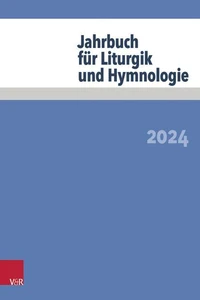Das Nunc dimittis ist der biblische Gesang des Simeon: "Herr, nun lässt du deinen Diener in Frieden fahren" (Lk 2, 29-32). Dieser kurze Text wird an verschiedenen Stellen in der Liturgie verwendet: im Nachtgebet, bei Bestattungen, beim Abendmahl. Das Buch geht auf Spurensuche zu diesem Lied in Liturgie und Literatur, Musik und Malerei.
Über den Text ist gepredigt worden (u. a. von Luther, Schleiermacher, Barth, Niemöller) und er findet sich literarisch verarbeitet (bei Büchner, T.
S. Eliot, Karel Capek, Ezra Pound). Lieder sind zu ihm gedichtet worden, zahllos sind die musikalischen Vertonungen (u. a. Gregorianischer Choral, Schütz, Mendelssohn, Palestrina, Pärt, J. S. Bach). Vielfach auch ist die Szene zwischen Simeon und Jesus gemalt worden (byzantinische Ikonen, Giotto, Fra Angelico, Dürer).
Der Band berücksichtigt die orthodoxe, römisch-katholische, evangelische und anglikanische Tradition.
[Nunc dimittis.
The Song of Simeon in Church, Art and Culture]
The Nunc dimittis is the biblical song of Simeon: "Lord, now lettest thou thy servant depart in peace" (Luke 2:29-32). This short text is used in various places in the liturgy: In the Night Prayer, at Funerals, at the Eucharist. It is also the gospelreading on Candlemas. About the text has been preached (i. a. by Luther, Schleiermacher, Barth, Niemöller); it has been literarily treated (by Büchner, T.
S. Eliot, Karel Capek, Ezra Pound); songs have been composed; countless are the musical settings (i. a. plainsong, Schütz, Mendelssohn, Palestrina, Pärt, J. S. Bach). Often the scene between Simeon and Jesus has been painted (icons, Giotto, Fra Angelico, Dürer).
The book goes in search of Simeon's Song in liturgy and literature, music- and art-history. It is ecumenical and takes into account Orthodox, Roman Catholic, Protestant and Anglican traditions.
Das Nunc dimittis ist der biblische Gesang des Simeon: "Herr, nun lässt du deinen Diener in Frieden fahren" (Lk 2, 29-32). Dieser kurze Text wird an verschiedenen Stellen in der Liturgie verwendet: im Nachtgebet, bei Bestattungen, beim Abendmahl. Das Buch geht auf Spurensuche zu diesem Lied in Liturgie und Literatur, Musik und Malerei.
Über den Text ist gepredigt worden (u. a. von Luther, Schleiermacher, Barth, Niemöller) und er findet sich literarisch verarbeitet (bei Büchner, T.
S. Eliot, Karel Capek, Ezra Pound). Lieder sind zu ihm gedichtet worden, zahllos sind die musikalischen Vertonungen (u. a. Gregorianischer Choral, Schütz, Mendelssohn, Palestrina, Pärt, J. S. Bach). Vielfach auch ist die Szene zwischen Simeon und Jesus gemalt worden (byzantinische Ikonen, Giotto, Fra Angelico, Dürer).
Der Band berücksichtigt die orthodoxe, römisch-katholische, evangelische und anglikanische Tradition.
[Nunc dimittis.
The Song of Simeon in Church, Art and Culture]
The Nunc dimittis is the biblical song of Simeon: "Lord, now lettest thou thy servant depart in peace" (Luke 2:29-32). This short text is used in various places in the liturgy: In the Night Prayer, at Funerals, at the Eucharist. It is also the gospelreading on Candlemas. About the text has been preached (i. a. by Luther, Schleiermacher, Barth, Niemöller); it has been literarily treated (by Büchner, T.
S. Eliot, Karel Capek, Ezra Pound); songs have been composed; countless are the musical settings (i. a. plainsong, Schütz, Mendelssohn, Palestrina, Pärt, J. S. Bach). Often the scene between Simeon and Jesus has been painted (icons, Giotto, Fra Angelico, Dürer).
The book goes in search of Simeon's Song in liturgy and literature, music- and art-history. It is ecumenical and takes into account Orthodox, Roman Catholic, Protestant and Anglican traditions.

 , qui est-ce ?
, qui est-ce ?